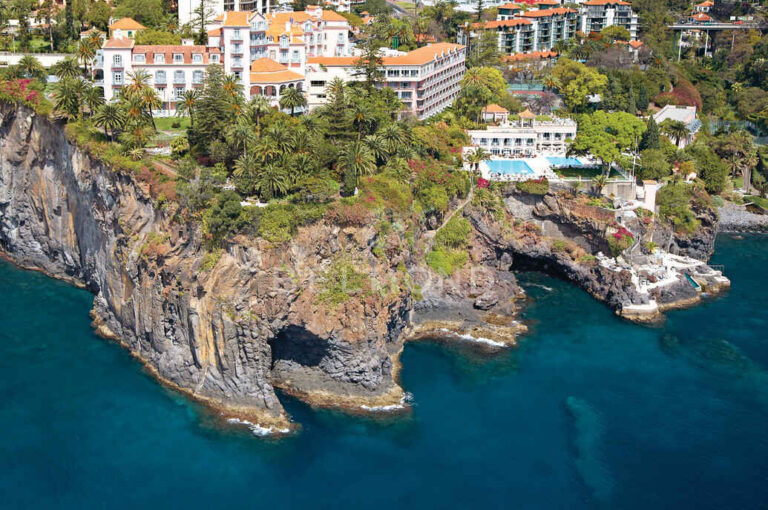
History, review and photos of the luxury hotel on the island of Madeira
At the end of February 2015, I stayed again at Reids. A year ago, it has changed its name to Belmond Reid’s Palace Madeira. After 30 years, the French railway company SNCF, who owns the Orient Express brand, had terminated its long-term license agreement for the trademark. Therefore, the name-change for all Orient-Express hotels. The group has not changed ownership. The introduction of “Belmond” was a simple matter of re-branding.
A history of Reid’s Palace – the biography of William Reid
The island of Madeira offers a mild climate throughout the year. It is the perfect holiday destination not only for a winter break.
Madeira was discovered in 1418. The following year, the Portuguese João Gonçalves Zarco, Tristão Vaz Teixeira and Bartolomeu Perestrelo set foot on the island.
In 1836, the Scotsman William Reid arrived on Madeira’s main city of Funchal, which is named after the wild fennel the first settlers found on its shores.
Born in 1822 as one of twelve children to a Kilmarnock farmer, William Reid was sent to Madeira on the advice of his family doctor. Because of his fragile health, he had been advised to live in a warmer climate.
The fourteen year old cabin boy was carrying five pounds from his father in his pocket, a respectable sum at the time. By the age of 25, the Scotsman had managed to move into the lucrative wine trade and to establish himself as a successful importer and exporter.

The two pools are heated. The bigger one is filled with sea water at 25 degrees centigrade, the smaller one is filled with freshwater and heated at 30 degrees centigrade. Another sea water pool is at sea level. In the background, you can admire a small part of the gorgeous garden surrounding the luxury hotel. All photos © Belmond / Reid’s Palace, Madeira.
William Reid married Margaret Dewey, who had come to Madeira as a companion for two years to a Lady Camden. William and Margaret had twelve children, a number of whom died in infancy.
In the mid-19th century, Madeira had established itself as a popular winter destination for visitors who wanted to escape the cold and damp climate in Northern Europe. They normally stayed for several months up to a year or two, mainly renting farm houses, so called Quintas.
William and Margaret Reid were fully aware of the opportunity and rented Quintas to wealthy travelers, offering their personal supervision and services.
In 1850, Tourism got a boost when the Austrian Empress Elisabeth “Sisi” spent five months on the island of Madeira. It was the time when William Reid and his wife opened their first hotel, Quinta das Fontes. With the blessing of HRH the Duke of Edinburgh, Alfred, the second son of Queen Victoria, they renamed it the Royal Edinburg Hotel.
Subsequently, the Reid’s established other hotels. For instance in Funchal the Santa Clara Hotel and the Miles Carmo Hotel. They also opened an accommodation in the mountain village of Monte, overlooking Funchal, as well as one in St. Anne’s (in present-day Santana) on the north coast.
The Reid’s themselves lived in one of the most prestigious Quintas, Quinta do Bom Sucesso. Built in 1881, it is since 1960 part of the Botanical Gardens of Madeira. Situated some three kilometers from the center of Funchal, it offers over 35,000 square meters of luxuriant vegetation.

The perfect bathroom with traditional Portuguese tiles. This is a view of a bathroom similar to the one in my Junior Suite 666. At the center, the bathtub with sea view. On the left, a separate shower. On the right a toilette. In the foreground on the left and right two elegant sinks. In the (invisible) back, a large wardrobe. The Portuguese tiles used throughout the hotel are copies of 18th century Azulejos. This is as good as it gets. [added on November 2, 2020: a few years ago, Orient-Express got a new brand name: Belmond. The only old photo we kept for this article © Orient-Express, now Belmond].
Birth of a legend – Reid’s New Hotel aka Reid’s Palace
Despite his economic success, William Reid still had one dream to fulfill: a luxury hotel for the rich. Therefore, he purchased the Horse’s Leap (Salto do Cavalo), a rocky cliff point, from Dr. Michael Grabham.
The Scotsman secured the services of the architect George Somers Clarke, who had completed work on the legendary Shepheard Hotel in Cairo, which had been destroyed in a fire. Incidentally, the original Shepheard Hotel dates back to 1841. A previous building on the site even served as the quarters to Napoleon while he was conquering Egypt. The hotel was destroyed in the Cairo fire of 1952 during the war with the British and rebuilt in 1957 as a modern and faceless tower. It currently operates as a four-star hotel. The more recommendable accommodation is the five-star Intercontinental just next door. Both hotels are within a two minutes walk of the Egyptian Museum of Cairo, whose artworks will be transferred to a new museum next to the Giza Pyramids in 2013, Insha’Allah.
Back to Reid’s: Building of what was initially called Reid’s New Hotel began in 1887. Sadly, William Reid died the following year. He was buried in the British cemetery in Funchal. It was up to his sons William and Alfred to open Reid’s New Hotel on November 1, 1891. It was a luxury retreat combining Edwardian elegance with the latest comforts of the day.
Fame arrived early because, on December 24, 1893 the Austrian Empress Elisabeth arrived at Reid’s. She still had to recover from the 1889-suicide of her son, Crown Prince Rudolf, who had famously shot his lover, Baroness Marie Vetsera, in the head and then killed himself in his hunting lodge in Mayerling (movies about the tragedy at Amazon.co.uk).
During Empress Elisabeth’s stay at Reid’s, British naval vessels calling at the island did her the honor of firing a royal salute each morning and a band played while the Austrian flag was hoisted. The Empress left the island on February 5, 1894. Henceforth, Reid’s was known as a harbor of seclusion of history’s great characters, as Andreas Augustin put it.

View of a Garden Suite. Photos © Belmond / Reid’s Palace, Madeira.
During the First World War, Reid’s remained closed. The war changed Europe. The last Austrian Emperor, Charles I (1916-18), spent the last months of his life on the island of Madeira. The exiled former monarch arrived on November 19, 1921 together with his wife Zita. First, they stayed at Villa Victoria, an annex of Reid’s New Hotel. The horrendous cost made them accept the offer of a wealthy banker to stay at his villa near Monte, where the emperor died on April 1, 1922 (not an April Fools’ joke). The ex-Empress Zita continued visiting her husband’s grave until she died, always staying at Reid’s.
One of the most famous guests in the inter-war period was the Irish playwright and co-founder of the London School of Economics, George Bernard Shaw. He stayed a the luxury hotel for six weeks in 1924. At Reid’s, the winner of both the 1925-Nobel Prize in Literature and the 1938-Oscar for Pygmalion (an adaption of his play) wanted to sunbath and master the Tango. Shaw famously left Max Rinder, the resident Tango instructor, a photograph with the inscription: “The only man who ever taught me anything” (books by George Bernard Shaw from Amazon.co.uk and Amazon.com).
The Earl of Birkenhead, the former Secretary of State for India and Lord Chancellor between 1919 and 1922, was a frequent guest at Reid’s. When he read the inscription on Shaw’s photograph, he added: “Could Birkenhead teach you no law? Do let us have a little less of your perfection, My Dear G.B.S.”
Despite prominent hotel guests and an education received in England, William and Alfred Reid encountered financial difficulties. In 1925, they were forced to sell their iconic hotel to the British company Reid’s Palace Hotel (Madeira) Ltd.
In 1937, another famous Madeiran family took over the hotel. The Blandy family, who had established a leading wine company in 1811, took over the hotel. The Blandy’s introduced the first major changes to the hotel structure since the opening in 1891. They built the East Wing and invested some £35,000.

View of a Suprior Room. Photos © Reid’s Palace, Madeira.
Sir Winston Churchill
In 1950, another world-famous guest arrived at Reid’s: Sir Winston Churchill. He had already seen the island in 1899 when he had been on his way to cover the Boer War in South Africa.
Winston Churchill arrived again on the island in January 1950 on board the Union-Castle liner Durban Castle. He stayed for roughly ten nights. On the island, he wrote the fourth volume of his war memoirs, The Hinge of Fate (order if from Amazon.com or Amazon.co.uk). Churchill also dedicated himself to his passion – painting – in the nearby fishing village of Câmara de Lobos. During his stay, he used a grey Rolls-Royce belonging to the Leacock family, including their chauffeur.
Sir Winston Churchill was treated like royalty. When he and his wife made their entry to the dining room at Reid’s, they were given a standing ovation. He had also received a great welcome by the people of Madeira. Churchill noted: “I’ve been greeted by many people in the world for whom I have done something but never in my whole life been greeted with such enthusiasm by people for whom I have never done anything.”
The Churchill’s occupied a suite on the first floor, today’s Churchill Suite, decorated with photographs of the statesman. To return to England, the Churchill’s took the flying boat from Funchal to Southampton.
More famous guests
Among the notable post-war guests at Reid’s Palace one also has to mention the visit of the former Italian King Umberto II in 1965. He was baptized “The King of May” (“Re di maggio”), because he only ruled one month in 1946 before he had to abdicate.
A famous long-term staying guest was Cuba’s ex-dictator General Fulgencio Batista. He had been ousted by Fidel Castro in the Cuban Revolution of 1959. Batista did not arrive as a poor man. He and his family spent two full years at Reid’s occupying the second floor.
In 1966/67, the Garden Wing was built. The works were completed on December 24, 1967; all its rooms were occupied that night. The following year, the two pools were opened. In 1970, Reid’s joined The Leading Hotels of the World.
In 1990, Reid’s closed down for further improvements in preparation of the centenary of its opening. Six suites were added above the restaurant. A new restaurant, the Villa Cliff was added.
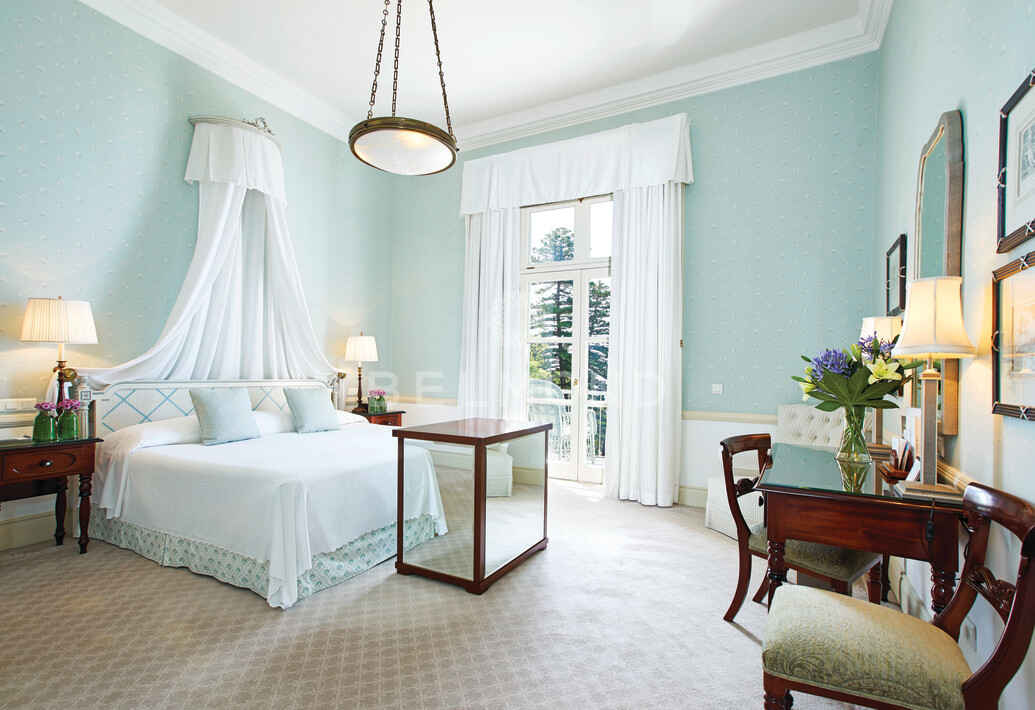
View of the Presidential Suite. All hotel rooms have a balcony with garden or garden/sea view. You can enjoy a breakfast in your room with a view! Photos © Reid’s Palace, Madeira.
An Orient-Express Hotel
In 1996, Orient-Express Hotels bought Reid’s from the Blandy’s. Another extensive restoration and renovation program followed. The designer involved was Graham Viney. In 2002 and 2003, the Villa Cliff changed its name to Villa Cipriani; at present, it is still the hotel’s Italian restaurant.
In 2006, Reid’s Palace was shut down for three months for the last big refurbishment of the rooms and suites. A new spa and gym were added, where I worked off my excess kilos. Each spa treatment room features its own private terrace and relaxation area.
For an entire week in 2010, the contestants for Miss Switzerland stayed at Reid’s. They had for instance a photo shooting around the historic changing rooms near the sea level pool.
I asked a hotel lifeguard whom he had had to save. He answered, unfortunately not a single Swiss Miss, but mostly men, because they tend to underestimate the sea more than the women.
In November 2011, Reid’s Palace will celebrate its 120th birthday.
My stay in January 2011
In January 2011, I stayed in one of my favorite rooms at Reid’s Palace, the Junior Suite 666, situated between the concierge and the reception, in the original part of the hotel. One highlight of room 666 is the large balcony with sea and garden view, enough room for two chairs and a table as well as two deck chairs. The other highlight is the elegant and spacious bathroom (check the bathroom photo above on the right). It does not get better than that.
Even if you are on a tighter budget, don’t worry. All rooms come with sea and/or garden view and at least with a small balcony or a small terrace. For instance the Charming Room 730, one of the smallest category, has a small bathroom, but a large terrace.
At Reid’s Palace, the welcome treat in my room were a bottle of Blandy’s – the wine company is still owned by descendants of the former owners of Reid’s – as well as two typical Madeiran cakes: Queijadinha, a homemade cheesecake produced with fresh cheese from Santo da Serra, and a Bolo de mel, a homemade cookie with sugarcane honey, spices and nuts (a bit on the dry side for my taste).
Among the many complementary amenities of the hotel are the deck chairs all around the property and the park with a fantastic sea view, several pools, the direct access to the sea, two tennis courts and table tennis tables, one kids club called Fun@Reid’s Kids for children from three to nine, plus a teenager club called Fun@Reid’s Teenagers, Minibars in the rooms with free soft drinks, including tomato, orange and apple juice, soda and tonic water, coca cola, ginger ale, etc. The hotel offers its DVD collection with some 80 classic DVDs free of charge. In my favorite Junior Suite 666, I watched All About Eve with Bette Davis (the film at Amazon.com, Amazon.co.uk, Amazon.de).
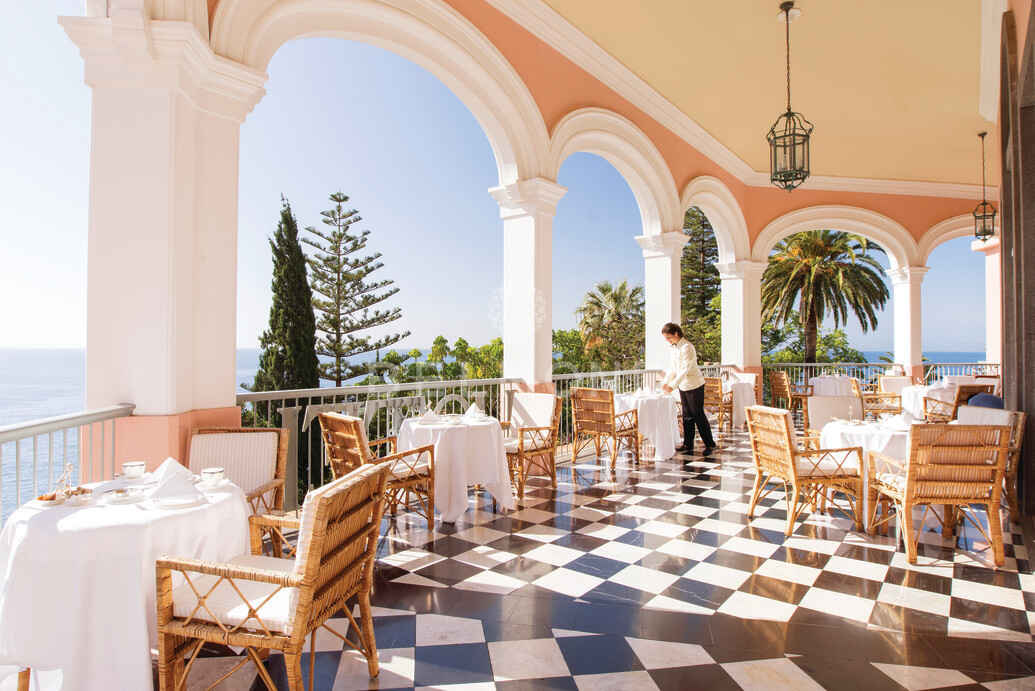
The afternoon tea on the terrace is an institution. Photos © Reid’s Palace, Madeira.
An afternoon tea on the terrace of Reid’s Palace
The Afternoon Tea at Reid’s is an institution that you should not miss. Excellent Italian teas by the Italian company La Via del Tè are served. I counted six black teas, six green teas and twelve different infusions to chose from.
When in Madeira, do as the Madeirans do. As an aperitif, I chose a Blandy’s Sercial Dry aged ten years with fresh fruit flavors and a dry tangy finish. For tea, my option fell on a mild and excellent Japanese Sencha.
The Afternoon Tea was served served on Wedgwood porcelain and on a classic three-tier stand. As in London, the scones with clotted cream, butter and jam will remain forever a British mystery to me. I liked my selection of vegetarian finger sandwiches, including avocado, zucchini and tofu, to mention a few. The bottom with the sweets included a raspberry macaron, a chocolate cake, a delicate mango, coconut and chocolate semifreddo with a strong mango flavor as well as my favorite, a fruit tart with guava, kiwi, tangerine and a grape.
Many tourists from other hotels flock to Reid’s to enjoy the view, the pianist and an unforgettable afternoon on the splendid terrace.
Incidentally, old photos show that the signs on the terrace balustrade originally read “Reid’s New Hotel”, since the hotelier had owned other hotels before. Today, just the “New” sign at the center is missing.
A concierge’s tales
The head concierge, José Manuel Aguiar Nunes, is currently the longest serving staff member. He began his career at Reid’s Palace in 1965 as a 12-year old pool boy. The first of his family members started working for Reid’s in 1894, just three years after the opening of the hotel. Among the many stories he remembers are the one about the occasional naked sleepwalker that turns up at the concierge’s desk or the lovely lady from outside the hotel who had had a drink too many and did not want to leave the bar anymore. She had to be accompanied outside with the help of four gentle hotel staff members, while she was claiming to be the “Queen of the Sahara.” Mister Aguiar has seen many famous guests stay at the hotel, among them, in 2010, the King and Queen of Spain. Roger Moore is a regular guest. One time, his luggage did not arrive at the airport with him; it had to be brought to the hotel later. The concierge still keeps the former James Bond’s luggage claim receipt. The concierge fondly remembers the night, at 3am, when the singer Sandie Shaw (e.g. “Puppet on a string”) insisted that he had to join her and her friends in her suite to share some champagne with them. As a concierge, you witness a lot. Privacy of course provides that the juicier stories remain within the walls of Reid’s Palace.
Orient-Express and Reid’s Palace
The Orient-Express company has thirty-nine hotels and six luxury trains in its portfolio. Since 1996, Reid’s Palace is owned and managed by Orient-Express, which completely renovated the five-star property with its 163 rooms and suites. Currently, for the first time since its opening some 120 years ago, the Grand Old Lady of luxury hotels in Madeira is run by a Portuguese general manager, Ulises Marreiros.
The largest group of hotel guests at Reid’s are the British, who account for some 40% to 50% of the stays. The second largest group are the Germans with 10% to 15% market share. Swiss, Austrians, Scandinavians and many other nations compose the rest. Americans are still rare to find.
A detailed hotel history by Andreas Augustin will be published in November 2011 for the 120th birthday of Reid’s Palace. It may contain new insights and may partly revise old stories. Some useful information can already be found in I had Tea at Reid’s Palace. An Afternoon Tea Companion by Andreas Augustin. 2008, 87 pages.
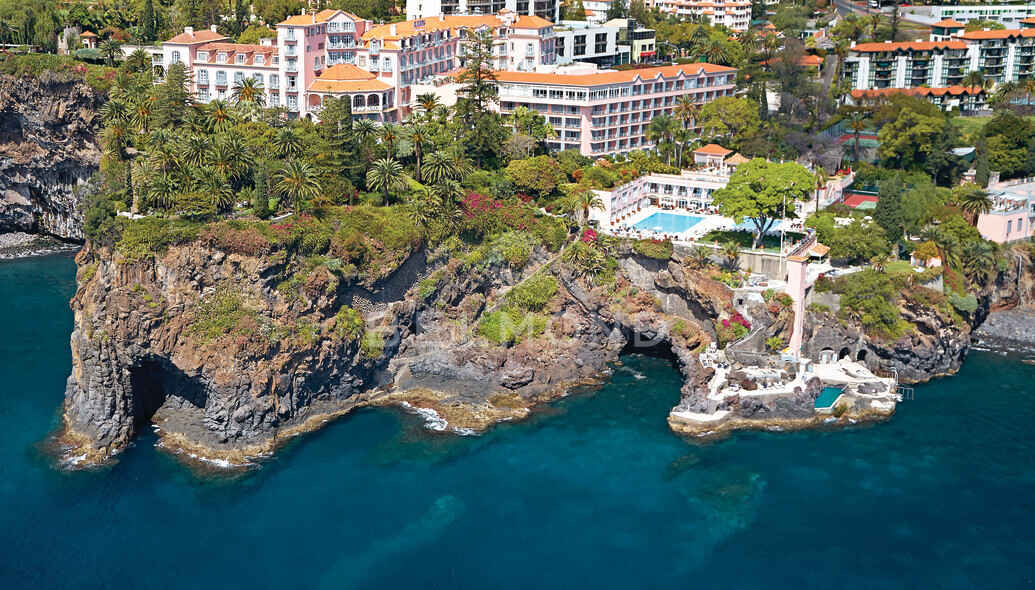
Aerial view of Reid’s Palace, Madeira. Photos © Orient-Express / Genivs Loci.
The Restaurants
For breakfast, “real tea” (tealeaves, not dreadful tea bags with broken tea or tea dust) from the Italian company La Via del Tè is served. I enjoyed a gunpowder green tea. The large breakfast buffet includes for instance Madeiran fruits, including a local passion fruit variety shaped like a banana, small Madeiran cherries, little plums of São João or the “banana prata”, a local banana variety.
The five restaurants at Reid’s Palace offer something for everyone. Well-known is the Italian restaurant Villa Cipriani with cliff top sea view from an adjacent building. I may test it on another visit. In January 2011, I enjoyed instead a dinner at Les Faunes, named after the Picasso lithographs displayed on its walls.
The executive chef responsible for all restaurant at Reid’s Palace is Luis Pestana (*1972), the son of a pastry chef. Luis Pestana told me that he had spent his entire career at Reid’s, including of course many shorter stays abroad. Among his important influences, he named André Bertron at Reid’s Palace at the time he was a trainee, who taught him French cuisine. At the Four Seasons in Milan in 1999, he was introduced to Sergio Mei’s own style of Italian cuisine. From the French 3* Michelin chef Marc Meneau, he learned the highest standard of French cuisine in 2008.
At Reid’s Palace, Luis Pestana offers a regular cuisine, a mix of French, Italian, local and international dishes. He focuses on organic produce. The menu changes according to the season, with a daily special created by the chef according to the best ingredients available. Les Faunes focuses a bit more on local specialties. He is no adept of nouvelle cuisine and chichi. He wants his clients to remember what they have eaten and not confuse them with exotic combinations and flavors.
The restaurant is well suited for vegetarians. I counted five starters, four soups and six main courses on the vegetarian menu. My courses were low in salt and spices, which the chef explained with the clientele in January, rather elderly people with no children who can travel in January. Tell him if you like it spicy. He will adapt to any guest’s wishes.
A particularity at Reid’s is live music throughout the hotel. Pianists and sometimes Fado singers entertain the guests. At Les Faunes in January, the Fado singer Eugenia Andrade made an excellent impression.
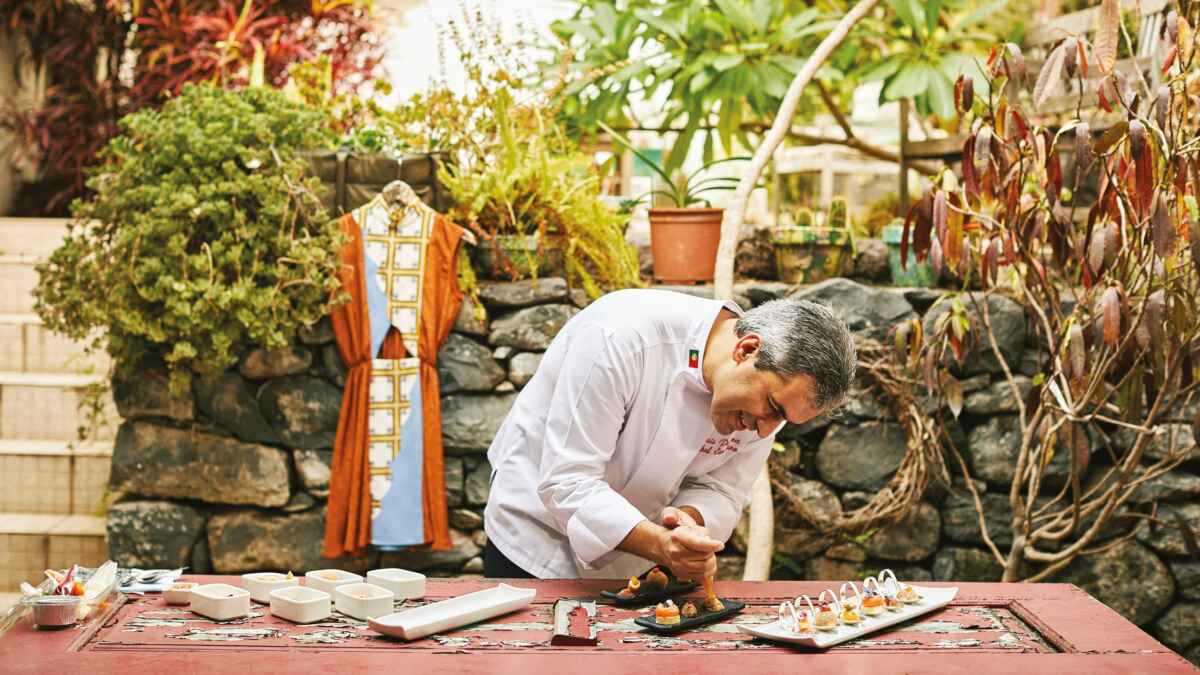
[Executive chef Luis Pestana. His William Restaurant was awarded a Michelin Star in 2017. Info and photo added on November 2, 2020. Photo copyright © Reid’s Palace, Madeira].
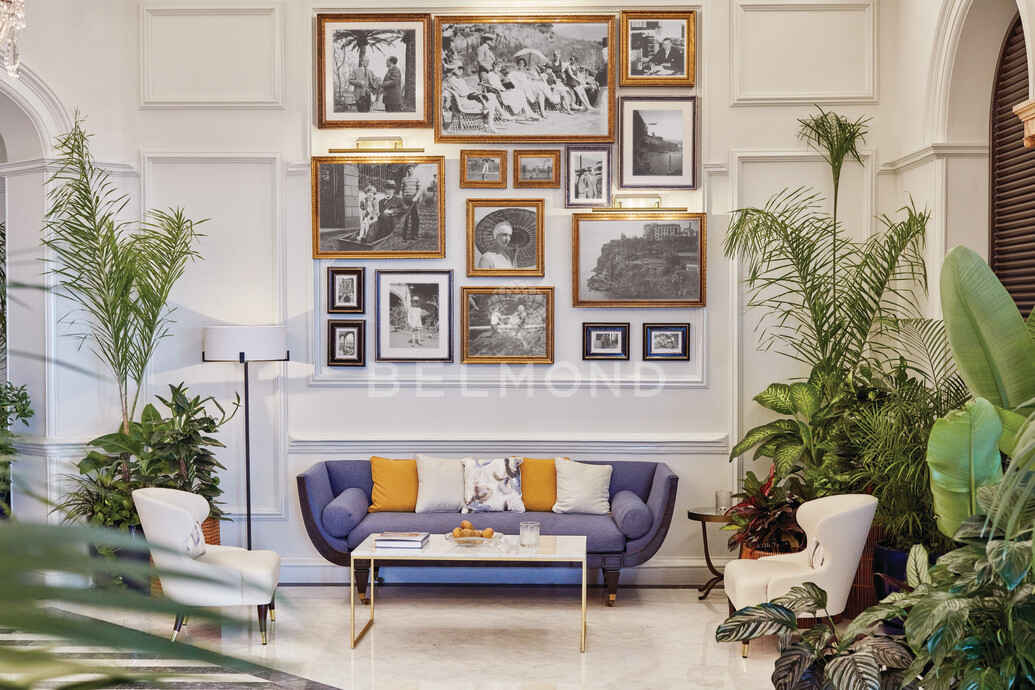
A public area at Reid’s Palace with historic photographs on the wall. Photo copyright: Reid’s Palace.
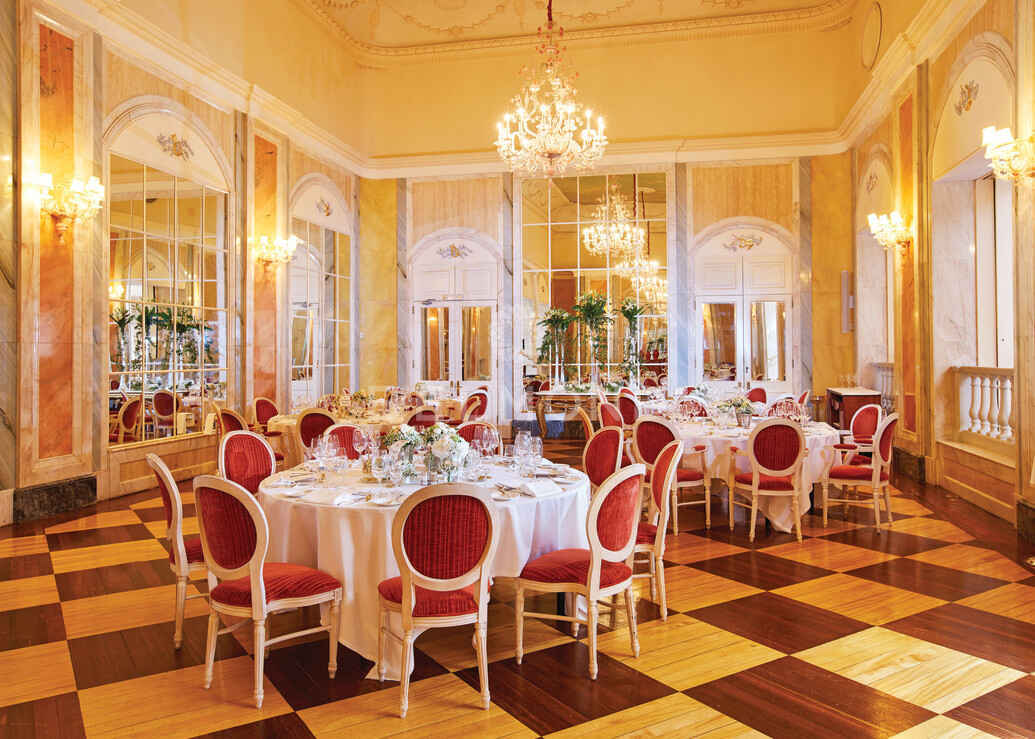
Here you can dine in style. Photos copyright: Reid’s Palace, Madeira.
Article added on February 1, 2011 at 00:16 Paris time [two details updated on February 2, 2011]. New photos added on November 2, 2020. All photographs are the copyright of Belmond / Reid’s Palace.